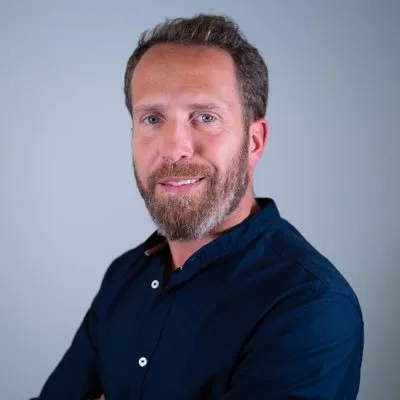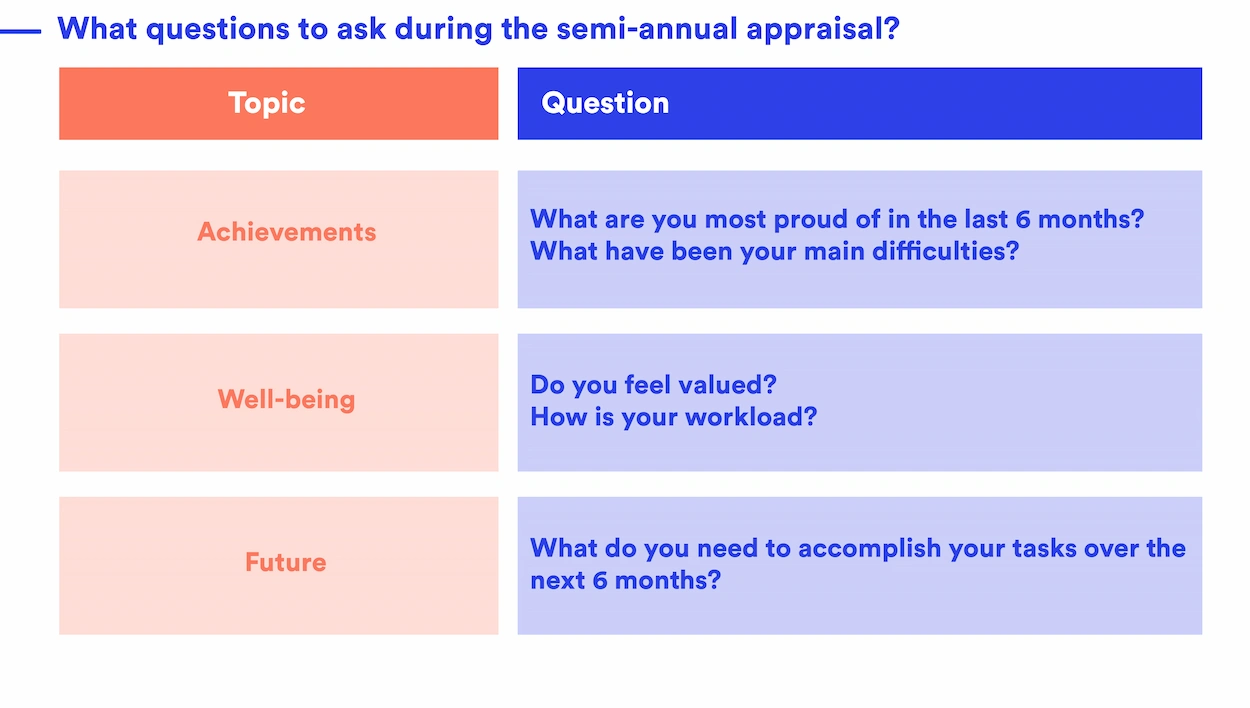You’re going to tell us “another interview”!!!! Well, yes: the mid-year interview is a pivotal moment, just before the summer, which helps to promote the company’s talents. When you look at the seasonality of departures, the period from May to September is absolutely crucial. Consequently, this mid-year meeting has the virtue of clarifying mutual expectations and identifying the risks of departure.
Although of vital importance in the follow-up of employees, the meeting can often be better structured and prepared. How do you set it up? How should it be structured? Don’t just carry it out, but ensure an engaging follow-up?
Properly conducted, the exchange proves particularly beneficial for each of the HR players, as they gain a better overview of the collaboration.
What are the differences between yearly and half-year performance reviews?
The main differences between annual and mid-year performance reviews relate to frequency, the tone used, the objectives sought, the period analyzed, the scope of the discussion and the follow-up and actions implemented.
Here are 6 differences:
- Frequency
- Annual appraisal : once a year, usually in January
- VS Half-year review : twice a year, halfway through the year and often in June.
- The Tone
- Annual appraisal: often more formal, focusing on the past year in retrospect.
- VS Half-Year Review : more flexible to encourage a more dynamic discussion of achievements and ongoing projects.
- Goals
- Annual appraisal: assess the employee’s overall performance, set objectives for the following year and plan long-term career development.
- VS Half-year Review: focus on progress on current projects, challenges encountered and adjustments needed to achieve set priorities.
- Period analyzed
- Yearly Appraisal: the whole of the previous year, enabling an overall assessment of performance over this period.
- VS Half-year review: in the first half of the current year, to identify progress made and areas for improvement.
- The scope of the discussion
- Annual appraisal: A broad vision, covering topics such as long-term aspirations, skills to be developed and career prospects.
- VS Half-year Review : a focus on operational and tactical issues, such as project progress, challenges encountered and adjustments needed.
- Follow-up and action plan
- Annual Appraisal: Following the annual interview, development plans can be put in place for the coming year, with specific training or intentions.
- VS Semi-annual interview : the mid-year exchange enables immediate adjustments to be made, more frequent feedback to be provided, and achievements and actions to be adapted for the rest of the year.
What are the challenges of Half-year appraisals?
Why conduct a mid-year HR interview?
Mid-year HR interviews play an essential role in analysing the work accomplished by an employee at the half-way stage. These "check-ins" during the year enable us to keep a close eye on the progress of employees' projects.
Annual appraisal interviews are generally held in January, but it is possible to hold a half-yearly interview once at the end of the year before the vacations. A June meeting, following the 1st half-year performance review and bonus awards, is particularly important.
These meetings and the resulting feedback are extremely beneficial for employees. They offer constructive feedback, whether positive or negative. What’s more, they enable those concerned to make adjustments if necessary, without waiting until the end of the year. In this way, employees are supported in improving their performance through continuous feedback.
What are the advantages of half-yearly interviews?
In a context of increasing managerial challenges and the need to re-enchant their role, mid-year interviews are a precious moment for managers, employees and Human Resources departments, especially if they are well structured and prepared:
- Collect formal data to enable HR departments and local managers to adjust their practices.
- Capitalize on a privileged moment of exchange for all parties. They enable expectations to be clarified and adjusted, thus fostering team cohesion.
- Offer a less stressful appraisal framework than the annual appraisal interview, encouraging positive feedback on the development of skills and the taking of initiatives towards more ambitious goals.
- Companies carry out transformation projects very frequently, so the discussion can focus on understanding the purpose and reinforcing the management of change.
- Orient the discussion towards the future and show greater empathy in adapting the career offer to the employee.
HR teams play an essential role in supporting managers in this exercise. Download the guide for the benevolent HR manager.
How do you prepare for and follow up a semi-annual Review?
A semi-annual interview is prepared on the basis of the employee's previous appraisals and established performance objectives, in order to identify support options and formalize a binding action plan.
The 5 steps to successful preparation :
- Review any comments or evaluations the employee completed at the previous mid-year review .
Preliminarily assess the requests and levels of satisfaction provided in advance, in order to understand the employee’s state of mind and aspirations. This will enable you to build your responses to these expectations, as well as the measures to be taken to maintain the momentum or improve the situation.
- Analyze the employee's performance objectives and project responsibilities.
Be prepared to ask questions designed to initiate a discussion on the areas in which the employee can make progress, on the posture or methods he or she needs to adopt right now to meet expectations of contribution to collective results.
- Identify opportunities for operational support.
Whether it’s mentoring, one-off internal mobility or training, determine the panorama of internal opportunities that will best impact the employee’s operational goals in the short term.
- Develop a clear structure for discussion topics at the meeting
In the run-up to the meeting, employees are asked to prepare the topics they wish to discuss. Define specific targets for each point raised, and plan strategies to encourage the employee ‘s participation and facilitate the progression of the conversation.
- Formalize new deliverables and an action plan
This meeting is also essential to prepare for the coming months: what are the upcoming projects? How can objectives be adjusted? To what extent are they relevant to the company’s resource planning ?
The pitfall often encountered is that this type of meeting is not followed up. Through its "Performance and Engagement" solution, Neobrain not only helps to keep track of the actions taken, but also automatically feeds the other dimensions of talent management: updating performance, development and skills objectives, and career development.
How do I follow up on semi-annual discussion?
What steps should you take to ensure that your meeting is not in vain?
- Send an email summarizing the meeting, highlighting key points, items to be confirmed (including dates on which the employee can expect to be informed) as well as an overview of upcoming commitments or changes and the date on which they will take effect.
- Honor your promises (training, mentoring, coaching, etc.) and inform the employee of their status. This part is essential to maintain trust between the different parties.
- Carefully archive your essential notes from the meeting so that you can easily find and remember them. (You can optimize this follow-up by using an automated tool). These written records will enable you to come back to the objectives and actions during subsequent meetings.
Mid-year interviews play a crucial role in retaining talent and high-potential employees. It’s a double-edged sword: depending on the content of the discussions, either momentum is maintained or increased, or blocking factors are revealed.
This is why“sticking your head in the sand” and making this event part of the corporate culture is a recognized retention factor. This meeting is the culmination of preparatory work on the part of the employee: evolution of skills, results obtained on these projects, and taking a step back on the levers for improvement. To maximize the effectiveness of the meeting, it is essential to structure and prepare it meticulously to serve the company’s HR priorities. The same applies to internal mobility interviews.
These meetings offer many benefits, such as constructive feedback, ambitious goals and a future vision of employees’ careers. Companies can take full advantage of these dialogues to foster employee growth and success.











